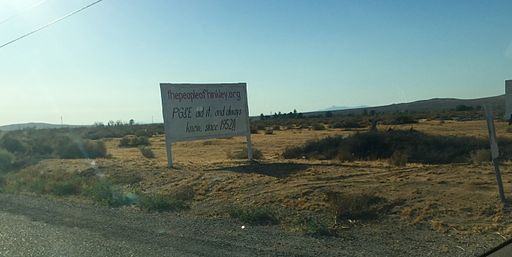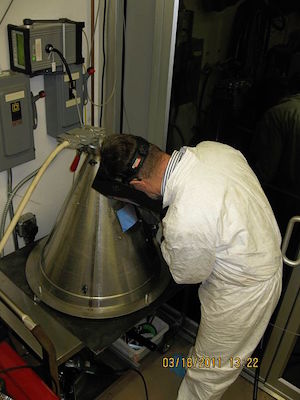by Susan Hellauer

Protest sign in HInkley, California. Photo: Alison Cassidy via Wikimedia Commons
Dry, dusty Hinkley, California, once a close-knit farming community, is disappearing into the desert.
The town in San Bernardino County was the scene of a dramatic 1990s environmental struggle, chronicled in the 2000 film Erin Brockovich. The legal battle between residents and energy company Pacific Gas & Electric over contaminated well water ended in 1996 with PG&E’s landmark $333 million settlement with local plaintiffs. The energy company admitted no culpability for diseases afflicting many Hinkley residents, but legal clerk Erin Brockovich had made the connection between a cluster of illnesses and groundwater contaminated by chromium-6—a carcinogenic heavy metal dumped with cooling-tower wastewater into an unlined catch basin at a PG&E gas-compression facility in Hinkley.

Erin Brockovich (2012). Photo: Eva Rinaldi via Wikimedia Commons
Brockovich, a struggling single mom, may have lacked a law degree (and a blouse adequate to cover her perky bosoms), but she had more than enough brains, compassion and grit to track down the source of the poison in Hinckley, and hold PG&E accountable. It’s a terrific and true American story, and it made a great, root-for-the-little-guy movie.
So, you’d think that PG&E would follow its 1996 payout with an immediate cleanup of the toxic chromium-6 that caused the trouble. But they did not. By 2009 the “plume” of contamination was spreading, and in 2010 PG&E began a program of either buying out residences and businesses, or providing them with clean drinking water.
You’d think as well that attention brought by the whopping settlement and the film must have led to quick, decisive government action to limit chromium-6 in drinking water. But you’d be wrong about that too.
Chromium: good twin-evil twin
The heavy metal chromium—odorless and colorless in water—exists in nature in two forms.
Chromium-3, or trivalent chromium, is an essential element in human nutrition. It’s found in most vitamin and mineral supplements, often listed simply as “chromium.” It even took its turn as an alleged miracle weight-loss supplement.
Chromium-6, or hexavalent chromium, also exists in nature, but is a known carcinogen that wreaks havoc on human health. Because of its many chemical and industrial uses, it frequently gets into the air, soil, and groundwater as a poisonous industrial byproduct.
Where’s the EPA when you need them?
Unregulated contaminants and bottled water
Sustainable Saturday won’t be encouraging plastic water bottles except as a last resort, but here is what you need to know:
Bottled water is regulated by the FDA, which has adopted the EPA’s interim “safety level” of 100 ppb for total chromium.
Manufacturers will provide specific information. We contacted Poland Spring, and Glaceau, maker of SmartWater. Both reported that chromium levels were “undetectable” in their products because of aggressive filtering (Poland Spring) or vapor distillation (SmartWater).
Since 1992, the US Environmental Protection Agency (EPA) has been enforcing a maximum contaminant level (MCL) of 100 parts per billion (ppb) for total chromium (chromium-3 plus chromium-6) in drinking water. This limit works under the assumption that the entire amount could be the dangerous chromium-6.
The US Occupational Safety and Health Administration (OSHA) has long asserted that chromium-6 in the workplace causes cancer and many other ailments. Thus it strictly regulates contact and inhalation by workers.
Now, a new report from the watchdog Environmental Working Group (EWG) presents scientific evidence supporting their belief that even a tiny amount of chromium-6 in drinking water poses a significant health threat.
By some estimates, more than 200 million Americans (in all 50 states) are drinking tap water contaminated with chromium-6. If, as EWG holds, the “safe” threshold is barely detectable, the people of Norman, Oklahoma, with a finding of almost 40 ppb, turn on their taps and get hot and cold running poison. (See EWG’s interactive map for test results.)
After conducting its own study, the EPA acknowledged in 2010 that chromium-6 may be a human carcinogen. They then planned and launched a series of nationwide drinking-water tests to assess the scope of the contamination and determine the need for new regulations. From 2013 to 2015—still in the testing phase—the EPA had water suppliers take more than 60,000 samples. Chromium-6 was found in over 75 percent of them.
Filling the gap, state by state

Welding in an enclosed chamber to collect fumes for analysis. The goal is to generate as little hexavalent chromium as possible. Welders have increased incidences of lung cancers and other respiratory diseases. Photo: National Institute for Occupational Safety and Health.
Without federal regulation of chromium-6 in drinking water, some states have attempted to impose their own limits. In 2010 California established a non-enforceable public health goal of 0.02 parts per billion in tap water which, based on recent science, their researchers believed to pose a “one in a million” risk over 70 years of consumption. After intense industry lobbying, an enforceable limit (MCL) for chromium-6 of 10 ppb—“500 in a million”—was established in 2014. (According to this formula, the current EPA threshold of 100 ppb results in a “5,000 in a million” risk.)
New Jersey and North Carolina have also attempted to act on research showing a cancer link, and have set a relatively low non-enforceable public health goal of 0.06 ppb for chromium-6. Enforceable limits in those states were thwarted, according to EWG, by political intervention on behalf of business interests.
Last February, Governor Cuomo launched a Water Quality Rapid Response Team on Long Island, “to swiftly address water quality issues across the state and develop new policies, programs, and technologies to ensure clean water for all New Yorkers.”
Officials from the NY State Department of Health said in a phone conversation that this new team would also be carefully evaluating any possible chromium-6 contamination:
The chromium-6 issue is complex: there are specific sources from industry, but there’s also a background level from geological formations. When we look at the data in earnest, we’ll be discerning what is background and what is from an industrial source. It’s much more challenging than organic chemicals produced solely through human activity. But there’s no question that chromium-6 contamination is a national problem.
Local water suppliers deal with it

Nyack Water Treatment Plant
In 2014, Rockland water suppliers SUEZ NY (formerly United Water) and the Nyack Water Department tested for chromium-6, as part of UCMG3—the EPA’s third round of unregulated contaminant monitoring for analytical purposes.
According to Supervisor Harry Williams, Nyack’s chromium-6 result was a low 0.037 ppb—just slightly higher than California’s aggressive public health goal of 0.02 ppb. SUEZ NY spokesperson Deborah Rizzi reported a chromium-6 result of 0.59 in the 2014 testing—about 16 times higher than the Nyack Water result, but still far below California’s statutory limit of 10 ppb.
Like water suppliers everywhere, SUEZ NY watches and waits: “We will continue to monitor the situation closely,” wrote Rizzi. “The EPA or states may choose to regulate chromium-6 in the future, and naturally we will comply with any changes in regulation that may occur.”
If regulation of chromium-6 becomes a reality—by either state or federal action—so will the cost of removing the contaminant from drinking water. Nyack Water and SUEZ NY are both well below the only existing regulatory level (California’s 10 ppb). But in many places the cost and feasibility of removal are issues that regulators, water suppliers and taxpayers will have to grapple with.
Hinkley now: a place with no future
What you can do
Sign the EWG petition to the EPA on chromium-6.
Write to the EPA and ask why it’s taking so long to regulate a proven human carcinogen.
Use the updated EWG guide to find a water filter that can remove this and other contaminants from your home drinking water.
According to EWG, the EPA has put their regulatory process on hold after agreeing to wait for the results of industry-funded research on how—not whether—chromium-6 induces cancer. Not until these reports are received and studied will the EPA decide whether to act on chromium-6 in drinking water. If they do act, proposals for enforceable limits would then be put forth for public comment—and that public will, of course, include the deep-pocketed chrome, chemical and other industries that produce or use chromium-6.
In April 2015, 19 years after the PG&E settlement, a Los Angeles Times reporter paid a visit to Hinkley. She found the remaining residents struggling to live in their dying town, the school already closed down, and essential businesses getting ready to do the same.
Almost twenty years after settling their case with families of the sick, dead and dying of Hinkley, PG&E was still awaiting completion of a cleanup master plan—one that could require many years to execute.
In a 2013 interview, Erin Brockovich spoke about the legacy of her “David and Goliath” victory:
I’m almost ashamed to say that after all we had been through with PG&E, I thought that PG&E would have addressed [the cleanup]. I walked away assuming that everything was OK, and it wasn’t. I feel duped, ashamed and really sad for the people of Hinkley.
Hinkley will be a ghost town. It will be another town lost in America due to pollution.
Learn more:
SUEZ NY 2015 water quality report. Chromium and chromium-6 results on p. 9
2010 CNN video report from Hinkley
2016 CNN report on chromium-6 in drinking water
Great scene (among many) with Julia Roberts from Erin Brockovich
Sustainable Saturdays, a weekly feature that focuses on conservation, sustainability, recycling and healthy living, is sponsored by Green Meadow Waldorf School, Maria Luisa Boutique and Strawtown Studio.











